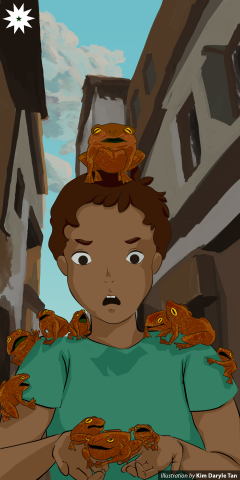Considered a national epidemic by the Department of Health last August 6, the dengue virus—a viral infection generally originating from a female mosquito species called Aedes aegypti, whose bite results in a flu-like illness—was reported to have claimed the lives of 622 people based on 146,062 cases that recorded during the months of January to July.
Warned of its looming threat, Matandang Balara Barangay Captain Allan Franza decided to release 1,000 bullfrogs into nearby bodies of water to curb the local mosquito population. Despite his good intentions, he did not anticipate the consequences of his initiative on the ecosystem.
A case of mistaken identity
What was initially an anti-dengue campaign by Franza turned into the unintentional introduction of an invasive species into the local ecosystem. Invasive species are organisms released into habitats they do not naturally thrive in. Due to the lack of natural predators, they are given the chance to flourish and increase their numbers. This may result in the foreign species ultimately disrupting the natural order of the original habitat and the organisms that live in it.
The dangerous implication of Franza’s actions were caused by a misunderstanding regarding the exact species of frogs he had released. Instead of bullfrogs, the species actually released were cane toads, highly poisonous animals that are harmful to any other organism that comes into contact with them. Netizens raised their concerns regarding the matter, one of which was the risk the cane toads had on the lives of other nearby species.
The risks were weighed by Br. Alfred Shields FSC Ocean Research (SHORE) Center Director Wilfredo Licuanan, who claims that invasive species could even cause the extinction of the native life due to factors such as some species having predatory natures or carrying diseases. “You have to think twice before introducing a species to an area where it is not native,” he stresses.
Putting it into perspective, cane toads reproduce quickly, mating year-round, with the females of the species laying up to 30,000 eggs at a time. On top of that, they are deadlier than their size implies. Cane toads possess poison glands, and ingesting their venom can be fatal for many animals.
This was the case in Victoria River, Australia, where poisoning due to cane toads killed at least 77 percent of the crocodile population, according to Charles Darwin University professor Keith Christian. Their constant reproduction—along with the ability to secrete a toxin deadly to most organisms—made the Invasive Species Specialist Group consider cane toads as one of the world’s worst invasive species.

Not the first
Barangay Matandang Balara, however, is not the only community that needs to deal with the problem of having invasive species enter neary habitats. Dagupan City had a similar anti-dengue initiative, releasing 6,000 mosquito fish stocks last August 16 into the waters of Barangay Pogo Grande.
Similar to cane toads, mosquito fish have high reproductive rates. Along with naturally being able to tolerate a wide temperature range of 0 to 38 degrees Celsius, mosquito fish also have the ability to survive in unfavorable water conditions. The combination of these traits allow the fish to spread and colonize more areas rapidly. Meanwhile, its predatory nature threatens the populations of economically desirable fish and other species.
Additionally, the Global Invasive Species Database warns the possibility of predatory mosquito fish eating the eggs of other fish, endangering the natural population growth of some species.
An ecological upset
“Organisms living in a place for a long time have evolved to [coexist],” the SHORE Center Director explains in his interview with The LaSallian. When an alien species is introduced to their natural habitat, the local ecosystem might be placed at risk.
“[Even] a good predator leaves enough of its prey to ensure sustainability,” says Licuanan.
Such were the cases of Australia and South America. Both had numerous plants and animals introduced to their lands, an example of which is when farmers release foreign species into the local ecosystem in the hopes of wiping out pests that threaten their harvest. What might have started as the harmless import of animals and crops has morphed and multiplied to the point of threatening the native species of the country.
With several attempts by the Australian government to halt the infestation in their respective communities, even wildlife officials have resorted to hunting and poisoning invasive plants and animals.
As Licuanan warns the dangers of introducing new species to an already established environment, he stresses that thorough research must always be done before a decision is made. The release of the cane toads and the mosquito fish may not be a priority issue for the aforementioned barangays, but just like in Australia, what seems like a viable solution could become a problem too much for an ecosystem to bear.
